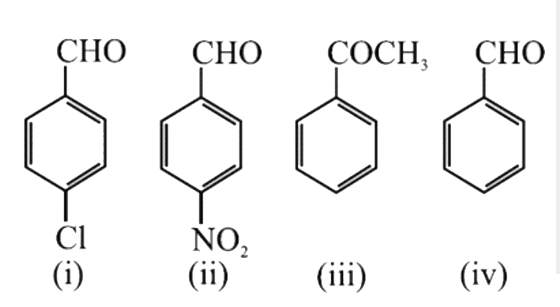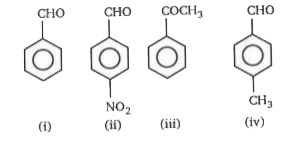Reaction of carbonyl compound with one of the following reagents involves nucleophilic addition followed by elimination of water. The reagent is:
hydrocyanic acid
sodium hydrogen sulphite
a grignard reagent
hydrazine in presence of feebly acidic solution
The correct Answer is:D
To solve the question regarding which reagent reacts with a carbonyl compound involving nucleophilic addition followed by the elimination of water, we can analyze the options provided:
1. Identify the Nature of the Reaction:
- The question specifies that the reaction involves nucleophilic addition followed by the elimination of water. This indicates that we are looking for a reagent that can act as a nucleophile and form a stable intermediate that can subsequently lose a water molecule.
2. Evaluate the Reagents:
- Option 1: Hydrocyanic Acid (HCN):
- HCN can act as a nucleophile due to the presence of the cyanide ion (CN⁻). However, the reaction with carbonyl compounds typically leads to the formation of cyanohydrins and does not involve the elimination of water.
- Option 2: Sodium Hydrogen Sulfide (NaHS):
- NaHS can provide HS⁻ as a nucleophile, but it does not lead to a reaction that involves the elimination of water. Instead, it forms thioethers or thiols.
- Option 3: Grignard Reagent (RMgX):
- Grignard reagents are strong nucleophiles and react with carbonyl compounds to form alcohols. However, this reaction does not involve the elimination of water.
- Option 4: Hydrazine (NH2NH2):
- Hydrazine acts as a nucleophile and can react with carbonyl compounds to form hydrazones. The reaction involves the nucleophilic addition of the NH2 group to the carbonyl carbon, forming an intermediate. This intermediate can then lose a water molecule, resulting in the formation of a double bond between carbon and nitrogen.
3. Conclusion:
- Based on the analysis, the reagent that fits the criteria of nucleophilic addition followed by the elimination of water is Option 4: Hydrazine (NH2NH2).
Final Answer:
The correct reagent is Hydrazine (NH2NH2).
- The question specifies that the reaction involves nucleophilic addition followed by the elimination of water. This indicates that we are looking for a reagent that can act as a nucleophile and form a stable intermediate that can subsequently lose a water molecule.
- Option 1: Hydrocyanic Acid (HCN):
- HCN can act as a nucleophile due to the presence of the cyanide ion (CN⁻). However, the reaction with carbonyl compounds typically leads to the formation of cyanohydrins and does not involve the elimination of water.
- Option 2: Sodium Hydrogen Sulfide (NaHS):
- NaHS can provide HS⁻ as a nucleophile, but it does not lead to a reaction that involves the elimination of water. Instead, it forms thioethers or thiols.
- Option 3: Grignard Reagent (RMgX):
- Grignard reagents are strong nucleophiles and react with carbonyl compounds to form alcohols. However, this reaction does not involve the elimination of water.
- Option 4: Hydrazine (NH2NH2):
- Hydrazine acts as a nucleophile and can react with carbonyl compounds to form hydrazones. The reaction involves the nucleophilic addition of the NH2 group to the carbonyl carbon, forming an intermediate. This intermediate can then lose a water molecule, resulting in the formation of a double bond between carbon and nitrogen.
- Based on the analysis, the reagent that fits the criteria of nucleophilic addition followed by the elimination of water is Option 4: Hydrazine (NH2NH2).
The correct reagent is Hydrazine (NH2NH2).
Similar Questions
Knowledge Check
- Question 1 - Select One
Which of the following compounds is most reactive towards nucleophilic addition reactions ?
ACH3−O∣∣C−HBCH3−O∣∣C−CH3C D
D
- Question 2 - Select One
Which of the following compounds is most reactive towards nucleophilic addition reactions ?
ACH3−O∣∣C−HBCH3−O∣∣C−CH3C D
D
- Question 3 - Select One
Which of the following compounds is most reactive towards nucleophilic addition reactions ?
ACH3−O∣∣C−HBCH3−O∣∣C−CH3C D
D
Which one of the following reagents is not suitable for the elimination reaction?
 View Solution
View SolutionArrange the following carbonyl compounds in decreasing order of their reactivity in nucleophilic addition reaction :
 View Solution
View SolutionSelect the reagent for the following reaction
 View Solution
View SolutionWhich of the following compounds is most reactive towards nucleophilic addition reactions ?
View SolutionArrange the following carbonyl compounds in decreasing order of their reactivity in nucleophilic addition reaction.
 View Solution
View Solution

